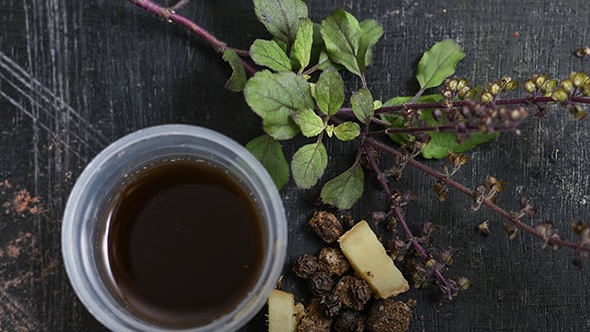Ashoka (Saraca asoca), jaggery, and water for decoction are the main constituents of Ashokarishta, along with their respective properties.

The well-known Ayurvedic remedy Ashokarishta is prepared from the bark of the Sarraca asoca, or Ashoka tree.1.In this blog, we’ll go over the components of Asokarishtam, how it’s made, its uses and benefits, usage guidelines, and potential adverse effects.
- Ashoka- It may have anticarcinogenic (preventing or delaying cancer) and antitumor
- Bibhitaki- it may have anti-inflammatory properties
- Vasa-It may be antispasmodic (Relieving muscle spasms)
- Mustaka- It may show anti-inflammatory activity
- Amrasthi- It may have potential antitumor properties
- Amalaki- It may have anti-oxidant (preventing cell damage), anti-inflammatory, immunomodulatory properties
- Nilotpala- It may show analgesic (pain relieving) and anti-inflammatory properties
- Krishna Jeeraka- It may be anti-spasmodic
- Haritaki- Anti-oxidant, Anti-carcinogenic
- Mustaka- It may show anti-inflammatory activity
- Shweta Jeeraka- It may posses antispasmodic and anticarcinogenic properties
- Daruharidra- It may demonstrate antitumor and anti-inflammatory properties
- Dhataki- It may have potential anti-tumor effect
Process of Preparation:
Ashoka tree bark can be collected and turned into a decoction. Ashokarishta is then made by processing additional medicinal herbs with this decoction and allowing them to organically ferment.
1. To extract the bark in powder form, wash and dry the Ashoka herb.
2. Boil a considerable amount of water with the powdered Ashoka bark to form the decoction.
3. Transfer the infusion into a glass jar and stir in the jaggery.
4. Bring to a boil and strain the mixture.
5. Next, powder the remaining ingredients that were previously indicated. Include this powder in the infusion.
6. Choose a temperature for the fermentation process to take place and use a cover to close the container.
7. After a few days of fermentation, Ashokarishta is created.
Potential Applications for Ashokarishta: The Ashoka tree was thought to have the ability to lessen grief in the past. It has earned the moniker “friend of women” since it may be helpful for a variety of medical issues. Based on the situation, Ashoka might be applied externally or within. Numerous possible applications for Ashokarishta exist, such as:
Possibly Applying Ashokarishta to the Skin:
Ashokarishta’s detoxifying qualities may improve skin tone and shield the body from pollutants. It works well for treating dark spots and acne as well. You should only use Ashokarishta if a skilled physician prescribes it because there isn’t enough data to support these possible advantages.
How to Take Ashokarishata:
Ashokarishata should be taken with the same amount of water after a meal. The dosage will be prescribed by your Ayurvedic doctor based on your age and health. Prior to starting therapy, you must have a thorough evaluation and diagnosis of your illness.
For information on the form and dose, speak with your Ayurvedic doctor. Furthermore, we recommend that you consult a physician or an Ayurvedic doctor before stopping any current medications or substituting them with any herbal remedies prepared from ashokarishta.
Adverse effects of Ashokarishta:
When taken at prescribed dosages, Ashokarishta is generally safer than contemporary substitutes. Notwithstanding the various applications of Asokarishtam, an excess of Ashokarishta may result in adverse reactions such as nausea and vomiting.
As a result, if you encounter any of these adverse effects, contact your doctor right away to get the medication that they prescribed. They will serve as the finest resource for advice on how to properly address side effects.
Precautions & Warnings to be Taken with Ashokarishta:
- Ashokarishta must be avoided if menstrual problems like heavy bleeding and menstrual pain have not shown any improvement.
- Ashokarishta is said to have a cardiotonic action (contraction of the heart muscle to improve blood flow). However, it should not be used in cardiac diseases without the doctor’s supervision.
- One must take extra precautions while giving it to children and elderly adults might develop a few harmful reactions in the body.
- Without consulting a doctor, people should not use ashokarishta to self-medicate themselves.